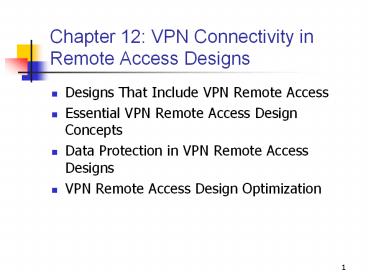Chapter 12: VPN Connectivity in Remote Access Designs - PowerPoint PPT Presentation
Title:
Chapter 12: VPN Connectivity in Remote Access Designs
Description:
Routing and Remote Access in Microsoft Windows 2000 includes. Remote access client ... Encrypt confidential data. Microsoft Point-to-Point Encryption (MPPE) ... – PowerPoint PPT presentation
Number of Views:70
Avg rating:3.0/5.0
Title: Chapter 12: VPN Connectivity in Remote Access Designs
1
Chapter 12 VPN Connectivity in Remote Access
Designs
- Designs That Include VPN Remote Access
- Essential VPN Remote Access Design Concepts
- Data Protection in VPN Remote Access Designs
- VPN Remote Access Design Optimization
2
VPN Remote Access Solutions
3
Routing and Remote Access and VPN
- Virtual private network (VPN) gives control over
- Authorized user accounts
- Security methods
- Resources to be accessed
- Uses Point-to-Point Tunneling Protocol (PPTP) and
Layer 2 Tunneling Protocol (L2TP) - VPN and Remote Authentication Dial-In User
Service (RADIUS) solutions differ in many ways.
4
Routing and Remote Access and Windows 2000
- Routing and Remote Access in Microsoft Windows
2000 includes - Remote access client
- Remote access server
5
VPN Clients and Servers
6
VPN Remote Access Design Review
- Amount of data transmitted
- Number of locations
- Existing Internet connections
- Plans for network growth
- Number of simultaneous clients
- Operating systems used by clients
- Protocols used by clients
7
VPN Remote Access Design Decisions
- Integration into existing network
- Hardware requirements for servers
- Protection for confidential data
- Availability to remote access users
- Optimization of network traffic
8
VPN Remote Access Designs
- A third party provides connectivity.
- Cost reduction is an advantage.
- Some dial-up security is not available.
- Caller ID detection
- Remote user callback
- Authentication protocol for dial-up connection
- Password security features
9
VPN Remote Access Scenario
10
Number of VPN Remote Access Servers
- Determine the maximum number of users.
- Determine the sustained data rate.
- Perform a pilot test.
- Calculate the number of servers.
11
Placing VPN Remote Access Servers
- Placement goals
- Centralize administration
- Reduce costs
- Reduce network traffic
- Single location
- Multiple locations
- Adjacent to resources
12
Single Location Configuration
- Provide enough PPTP or L2TP virtual ports.
- Advantages
- Centralized administration
- Lower administration costs
- Disadvantages
- Increased network traffic on segments
- No redundancy
13
Multiple Location Configuration
- Provide enough PPTP or L2TP virtual ports.
- Advantages
- Reduced network traffic between locations
- Redundancy
- Disadvantages
- Decentralized administration and support
- Increased administration costs
14
Placing VPN Servers Near Resources
- Reduces the segments traversed
- Improves performance for remote access clients
15
Remote Access Client Support
- Virtual ports
- PPTP
- L2TP
- Transport protocols determined by client needs
- Network address assignment methods
- Allocate manually
- Allocate automatically using Dynamic Host
Configuration Protocol (DHCP)
16
Preventing Unauthorized Access
- Restrict remote access to resources on the
server. - Use filters to restrict traffic on servers.
- Place VPN servers for security
- Outside the private network
- On screened subnets
- Within the private network
17
Placing VPN Servers Outside the Private Network
18
Placing VPN Servers on Screened Subnets
19
Placing VPN Servers Inside the Private Network
20
Protecting Remote Access Data
- Authenticate remote users.
- Local accounts
- Active Directory directory service accounts
- Encrypt confidential data.
- Microsoft Point-to-Point Encryption (MPPE)
- Internet Protocol Security (IPSec)
- Enforce remote access policies.
21
Enhancing Remote Access Availability
- Use redundant VPN remote access servers.
- Network Load Balancing
- Round robin DNS
- Use multiple Internet connections.
- Dedicate a computer to running Routing and Remote
Access.
22
Improving Remote Access Performance
- Upgrade hardware.
- Distribute clients across multiple servers.
- Use Network Load Balancing.
- Use round robin DNS.
- Dedicate a computer to running Routing and Remote
Access.
23
Chapter Summary
- There are many advantages in using VPN for remote
access. - Consider the number of users and the data rate.
- Use multiple remote access servers.
- Evaluate the needs of remote clients.
- Protect private network resources.
- Improve the availability and performance of the
design.































